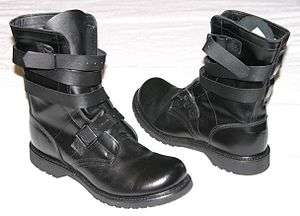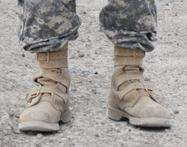Tanker boot


Tanker boots are military boots[1][2] closely associated with soldiers who serve on tanks and tracked vehicles in general.[1] It is said the idea was borrowed from the French crewmen encountered during World War I when then-Captain George S. Patton, Jr. established the United States Tank Corps. Whereas regular combat boots are laced through metal eyelets in the leather upper, the tanker boots are fastened with leather straps which wrap around the upper and buckle near the top. This benefits the wearer in several ways:
- The leather straps are advantageous specifically to those working inside tanks. The problem with laces is that they can become undone easily and then entangled in the many exposed, moving parts of a tank, and drag the wearer or part of his body into the machinery.
- Many boots have nylon or canvas panels in their uppers and also nylon laces which will melt if exposed to fire. Melting boots and laces will serve to further injure a crewman and make his evacuation of the vehicle more difficult.
- Tracked crewmen typically find themselves working in very muddy environments. Another advantage of tanker boots is that they are much easier to loosen than a regular laced boot[1] when caked in mud.
- Also, today's modern tankers are exposed to many harmful chemicals - Flame-Resistant Hydraulic Fluid (FRH), turboshaft engine oil, grease, oils and various fuels. The all-leather construction of tanker boots prevents absorption of these chemicals into the boots and coming into close and prolonged contact with the wearer's skin.
- Tanker boots also allow for improved circulation to crewmember's feet, as they may be sitting or immobile for long periods of time. Tank crewman during the Gulf War reported remaining seated at their gunners', drivers', and commanders' stations for periods up to the entire 100 hours of ground combat.
- Tanker boots, unlike most traditional combat boots, have the tongue sewn into the boot up to about 1 to 1.5 inches (25 to 38 mm) shy of the top of the boot, to make the boot more readily waterproofed (up to 14 in (360 mm) of water depth can be stood in without ingress of water when sealed/waxed properly, depending on the height of the boot design); the tongue is made with excess leather left and right that doesn't require it to separate to remove the foot. However, the new desert tanker boots are not waterproof at all.
- Tanker boots are normally equipped with steel toe guards, steel or plastic shank/heel guards, and in at least modern variants, steel or other protective metal inserts in portions of the sole as well, as befit a boot intended for an operating environment filled with metal hazards that can be accidentally kicked/dropped/stepped upon/et cetera (as opposed to the traditional combat boot designed for a sandy or muddy battlefield environment). When the desert tanker boots came out, it was not authorized to have steel toe inserts for fear that the crewman may have his toe cut off if too much weight was put on the boot.
Tanker boots have a significant disadvantage over traditional lace up combat boots in that they provide comparatively little ankle support; however for troops that fight sitting in an armoured vehicle, this is relatively unimportant. An unauthorized variant of the tanker boot is the cavalry boot, or 'cav boot', which is higher above the ankle (in imitation of riding boots worn by the old horse cavalry) and might be worn by soldiers assigned to armored cavalry squadrons and scout units. The cav boots are more commonly seen being worn by officers in armored cavalry units.
References
- 1 2 3 Army, Volume 33, Association of the United States Army. "For combat-vehicle crewmen, there is a new tanker's boot under development. With a wraparound strap-and-buckle- closure system for easy donning and doffing, the new boot comes with a "chevron" design and a semiwedge heel"
- ↑ Inside the Us Army, Gordon L. Rottman